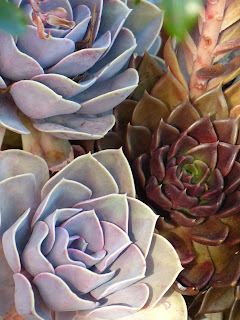 |
| Bonchus for Sonchus! THE TREE DANDELIONS |
It's that time of year in my garden when the over-sized cousin of the dandelion from the Canary Islands are in full bloom in all their splendor - Sonchus, pronounced son (not as in sun)-kus).
Once a friend of mine commented on the amount and number of species I had of this rare species and remarked that I'd gone "bonchus for Sonchus!" and I vowed to remember this witty remark in case I ever wrote a blog.
These plants unfortunately are rare, and I have only seen one species (S.palmeri) only once for sale at the rare plant fair at Clarendon a couple years back. I have been growing this species for a few years and many of my plants are well established now.
Of all the varieties from the Canary Islands grown with winter rainfall and summer dormancy, some occur in mountain forests with reasonable shade and others are cliff dwelling coastal species. They are perennials that get woody with age and germinate easily from seed in winter. I grow three species that stand out for their ornamental value and these I will deal with in detail:
SONCHUS ACAULIS
I often substitute this species for ferns in dry climate gardens in semi-shaded positions. They have very ornamental serrated though soft leaves that form a rosette to 1 metre across by half that height. In spring, a tall inflorescence shoots up from the middle of the plant bearing very large dandelion-like flowers that bees love.
Great as a dramatic stand alone understorey plant or mass planted for affect.
SONCHUS CANARIENSIS
This variety is the largest of the species and is known as the Giant Sow-Thistle and is truly of tree-ish proportions. In my garden they grow quite tall and straight like miniature palm trees. The leaves have a blueish green sheen with silverish undersides. In more maritime climes they grow much larger to 2m x 2m and with a more branching and sprawling habit. In times of summer drought my plants lose all their leaves and become dormant like thin candlesticks, much like some species of Senecio would. As cooler and wetter autumn weather hits, they sprout fresh new leaves and grow vigorously over winter. They flower with a complex head of small flowers.
SONCHUS HIERRENSIS
This variety has very ornamental dark green serrated leaves and large decorative yellow blooms. The leaves and the flowers have a bloom of down that is soft and does not irritate. I have grown it only in semi-shade in dry soil under trees but it may be more compact in full sun.
Enjoy!


















